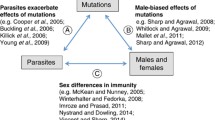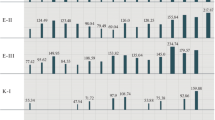Summary
The spontaneous mutation rate in the two sexes was studied in flies from various stocks, mainly isogenic wild-type, reared under controlled and identical conditions. It was found to be markedly higher in the male, the difference being statistically significant. Fluctuations were considerable, even within the same experiment, and point to the necessity for strictest control of all conditions when gaining data on spontaneous mutations. Possible explanations for the observed results are discussed, but without further evidence along other lines no decision between them appears possible.
Similar content being viewed by others
References
Auerbach, C. (1940). “Tests of carcinogenic substances in relation to the production of mutations inDrosophila melanogaster.”Proc. roy. Soc. Edinb. 60, 164–73.
Buchmann, W. &Timoféeff-Ressovsky, N. W. (1935). “Über die Wirkung der Temperatur auf den Mutationsprozess beiDrosophila melanogaster. II. Behandlung der Männchen mit Temperaturschocks.”Z. indukt. Abstamm.- u. VererbLehre,70, 130–7.
—— —— (1936). “Über die Wirkung der Temperatur auf den Mutationsprozess beiDrosophila melanogaster. III. Behandlung der Weibchen mit Temperaturschocks.”Z. indukt. Abstamm.- u. VererbLehre,71, 335–40.
Donald, H. P. &Lamy, R. (1937). “Ovarian rhythm inDrosophila.”Proc. roy. Soc. Edinb. 57, 78–96.
Döring, H. (1937). “Über den Einflusz der Ernährung auf die Mutationshäufigkeit beiAntirrhinum majus.”Ber. dtsch. bot. Ges. 55, 167–82.
Harris, B. B. (1929). “The effects of ageing of X-rayed males upon mutation frequency inDrosophila.”J. Hered. 20, 299–302.
Huettner, A. F. (1923). “The origin of the germ cells inDrosophila melanogaster.”J. Morph. 37, 385–423.
Lobashov, M. E. (1935). “On the nature of the action of chemical agents on the mutation process ofDrosophila melanogaster.” Candidate’s dissertation, Leningrad. Univ. Also, under title “Über die Natur der Einwirkung der chemischen Agentien auf den Mutationsprozess beiDrosophila melanogaster”, inGenetica (1937),19, 200–41 andTrud. Leningr. Obsh. Estestv. (1937),66, 345–76. (Russian with German summary.)
Lobashov, M. E. &Smirnov, F. A. (1934). “On the nature of the action of chemical agents on mutational process inDrosophila melanogaster. II. The effect of ammonia on the occurrence of lethal transgenations.”C.R. Acad. Sci. U.R.S.S. N.S.3, 174–8. (Russian and English text.)
Magrzhikovskaja, K. V. (1936). “The influence of CuSO4 on the mutational process inDrosophila melanogaster.”Bull. Biol. Med. exp. U.R.S.S. 2, 90–2.
—— (1938). “The effect of CuSO4 on the mutation process inDrosophila melanogaster.”Biol. Zh. (Mosc.),7, 635–42. (Russian with English summary.)
Muller, H. J. (1928). “The measurement of gene mutation rate inDrosophila, its high variability, and its dependence upon temperature.”Genetics,13, 279–357.
—— (1935). “Balancing chromosome I with scute-S.”D.I.S. 3, 50.
-- (1940). “On judging the significance of a difference obtained by averaging essentially different series.” (In Press inAmer. Nat.)
Muller, H. J. &Altenburg, E. (1919). “The rate of change of hereditary factors inDrosophila.”Proc. Soc. exp. Biol. 17, 10–14.
Olenov, J. M. (1939). “New data on spontaneous mutations.”Nature, Lond.,143, 858–9.
Plough, H. H. &Ives, P. T. (1932). “New evidence of the production of mutations by high temperature, with a critique of the concept of directed mutations.”Proc. 6th int. Congr. Genet. 2, 156–8.
—— —— (1935). “Induction of mutations by high temperature inDrosophila.”Genetics,20, 42–69.
Promptov, A. N. (1934). “Die Wirkung erhöhter Temperatur auf die generative Anlage im Ei vonDrosophila melanogaster.”Biol.Zh.(Mosc.),3, 126–45. (Russian with German summary.)
Sacharov, V. V. (1932). “Erregung des Mutationsprozesses beiDrosophila melanogaster durch Jodbehandlung.”Biol. Zh. (Mosc.),1 (3/4), 1–8. (Russian with German summary.)
—— (1933). “Auslösung von Mutationen beiDrosophila melanogaster durch Jodeinwirkung. II. Auslösung von Letalfaktoren.”Biol. Zh. (Mosc.),2, 414–18. (Russian with German summary.)
—— (1935). “Jod als chemischer Faktor, der auf den Mutationsprozess vonDrosophila melanogaster wirkt. III. Auslösung autosomaler Letalfaktoren.”Biol. Zh. (Mosc.),4, 107–12. (Russian with German summary.)
Sacharov, V. V. (1936). “Jod als chemischer Faktor, der auf den Mutationsprozess vonDrosophila melanogaster wirkt.”Genetica,18, 193–216.
—— (1938). “On the specificity of the action of the factors of mutation.”Biol. Zh. (Mosc.),7, 595–618. (Russian with English summary.)
Singh, R. B. (1940). “The influence of age and prolongation of larval life on the occurrence of spontaneous mutations inDrosophila.” Ph.D. thesis, University of Edinburgh, 79 pp.
Stubbe, H. &Döring, H. (1938). “Untersuchungen über experimentelle Auslösung von Mutationen beiAntirrhinum majus. VII. (Über den Einflusz des Nährstoffmangels auf die Mutabilität.)”Z. indukt. Abstamm.-u. VererbLehre,75, 341–51.
Timoféeff-Ressovsky, N. W. (1935). “Über die Wirkung der Temperatur auf den Mutationsprozess beiDrosophila melanogaster. I. Versuche innerhalb normaler Temperaturgrenzen.”Z. indukt. Abstamm.- u. VererbLehre,70, 125–9.
Zuitin, A. I. (1937). “Influence of temperature contrasts on the frequency of lethal mutations inDrosophila melanogaster.”C.R. Acad. Sci. U.R.S.S. N.S.15, 351–4.
—— (1938a). “The influence of the change of the thermal regime upon the frequency of occurrence of lethal mutations inDrosophila melanogaster.”C.R. Acad. Sci. U.R.S.S. N.S.21, 53–5.
—— (1938b). “The combined effect of change of the thermal regime and the subsequent temperature contrast upon the frequency of lethal mutations inDrosophila melanogaster.”C.R. Acad. Sci. U.R.S.S. N.S.21, 56–8.
Author information
Authors and Affiliations
Rights and permissions
About this article
Cite this article
Auerbach, C. The effect of sex on the spontaneous mutation rate inDrosophila melanogaster . Journ. of Genetics 41, 255–265 (1941). https://doi.org/10.1007/BF02983022
Issue Date:
DOI: https://doi.org/10.1007/BF02983022




